The multilayer flexible packaging market is expected to grow from USD 45.2 billion in 2025 to USD 72.9 billion by 2035, representing substantial growth and demonstrating the accelerating adoption of advanced barrier technology and preservation optimization across food processing facilities, beverage operations, and pharmaceutical packaging sectors. Future Market Insights, acknowledged for verified research on smart packaging adoption and logistics systems, states that the multilayer flexible packaging market stands at the threshold of a decade-long expansion trajectory that promises to reshape food preservation technology and consumer packaging solutions.
The first half of the decade (2025-2030) will witness the market climbing from USD 45.2 billion to approximately USD 58.6 billion, adding USD 13.4 billion in value, which constitutes 49% of the total forecast growth period. This phase will be characterized by the rapid adoption of high-barrier multilayer systems, driven by increasing consumer demand for extended shelf life and the growing need for advanced preservation solutions worldwide. Enhanced barrier capabilities and automated quality control systems will become standard expectations rather than premium options.
The latter half (2030-2035) will witness continued growth from USD 58.6 billion to USD 72.9 billion, representing an addition of USD 14.2 billion or 51% of the decade's expansion. This period will be defined by mass market penetration of smart packaging technologies, integration with comprehensive supply chain platforms, and seamless compatibility with existing food processing infrastructure. The market trajectory signals fundamental shifts in how food manufacturers approach product preservation and consumer convenience, with participants positioned to benefit from growing demand across multiple material types and application segments.
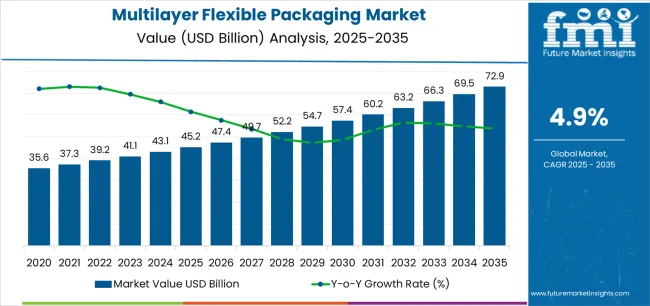
| Period | Primary Revenue Buckets | Share | Notes |
|---|---|---|---|
| Today | Food & beverage packaging (barrier films, pouches) | 52% | Volume-driven, shelf-life optimization |
| Pharmaceutical & healthcare packaging | 18% | Regulatory compliance, sterile barrier | |
| Personal care & cosmetics | 12% | Premium aesthetics, product protection | |
| Industrial & chemical packaging | 10% | Chemical resistance, containment | |
| Agricultural & seed packaging | 8% | Moisture control, extended storage | |
| Future (3-5 yrs) | Smart barrier systems | 35-40% | Active packaging, freshness indicators |
| Premium food packaging | 25-30% | Convenience features, portion control | |
| Pharmaceutical specialty films | 15-20% | Temperature-sensitive, tamper-evident | |
| E-commerce packaging solutions | 12-15% | Shipping protection, consumer experience | |
| Recyclable multilayer systems | 8-12% | Circular economy, environmental compliance | |
| Digital printing integration | 5-8% | Customization, brand differentiation |
| Metric | Value |
|---|---|
| Market Value (2025) | USD 45.2 billion |
| Market Forecast (2035) | USD 72.9 billion |
| Growth Rate | 4.9% CAGR |
| Leading Technology | Polyethylene-based Films |
| Primary Application | Food & Beverage Segment |
The market demonstrates strong fundamentals with polyethylene-based multilayer systems capturing a dominant share through advanced barrier properties and food preservation optimization. Food and beverage applications drive primary demand, supported by increasing consumer expectations for product freshness and extended shelf life requirements. Geographic expansion remains concentrated in developed markets with established food processing infrastructure, while emerging economies show accelerating adoption rates driven by urbanization and rising consumer spending patterns.
Design for circularity, not just performance
Primary Classification: The market segments by material type into polyethylene-based films, polypropylene-based films, polyamide-based films, and specialty barrier materials, representing the evolution from basic packaging films to sophisticated preservation solutions for comprehensive food and pharmaceutical protection optimization.
Secondary Classification: Application segmentation divides the market into food & beverage, pharmaceutical & healthcare, personal care & cosmetics, industrial & chemical, and agricultural sectors, reflecting distinct requirements for barrier properties, shelf-life extension, and product protection standards.
Tertiary Classification: Technology segmentation covers co-extrusion, lamination, coating, and metallization processes, while end-use formats span pouches, bags, wraps, lidding films, and specialized packaging solutions.
Regional Classification: Geographic distribution covers North America, Latin America, Europe, Asia Pacific, and Middle East & Africa, with developed markets leading adoption while emerging economies show accelerating growth patterns driven by food processing modernization and consumer lifestyle evolution.
The segmentation structure reveals technology progression from standard barrier films toward sophisticated multi-functional packaging systems with enhanced preservation and convenience capabilities, while application diversity spans from food processing facilities to pharmaceutical packaging operations requiring precise barrier control solutions.
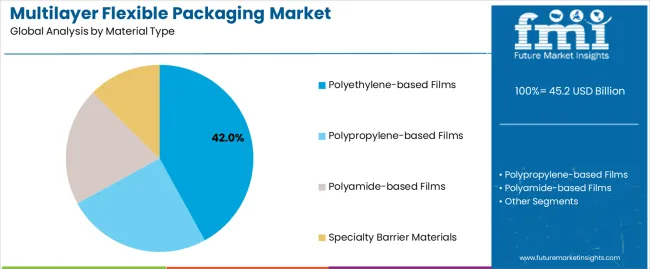
Market Position: Polyethylene-based Films systems command the leading position in the multilayer flexible packaging market with 42% market share through advanced barrier features, including superior moisture resistance, seal integrity, and food preservation optimization that enable packaging operations to achieve optimal product protection across diverse food and consumer environments.
Value Drivers: The segment benefits from food manufacturer preference for reliable barrier systems that provide consistent preservation performance, cost-effective processing, and operational efficiency optimization without requiring significant infrastructure modifications. Advanced material features enable automated packaging processes, consistent sealing properties, and integration with existing food processing equipment, where preservation performance and food safety represent critical facility requirements.
Competitive Advantages: Polyethylene-based Films systems differentiate through proven barrier reliability, consistent processing characteristics, and integration with automated packaging systems that enhance facility effectiveness while maintaining optimal preservation standards suitable for diverse food and beverage applications.
Key market characteristics:
Polypropylene-based Films systems maintain a 28% market position in the multilayer flexible packaging market due to their excellent clarity properties and heat resistance advantages. These systems appeal to facilities requiring high-temperature processing with superior optical characteristics for premium food applications. Market growth is driven by food industry expansion, emphasizing reliable barrier solutions and operational efficiency through optimized film designs.
Polyamide-based Films systems capture 18% market share through specialized barrier requirements in pharmaceutical facilities, high-performance food packaging, and industrial applications. These facilities demand superior oxygen barrier systems capable of handling sensitive products while providing effective protection capabilities and processing flexibility.
Specialty Barrier Materials applications account for 12% market share, including advanced coating technologies, nano-barrier systems, and bio-based materials requiring maximum barrier performance capabilities for specialized preservation and environmental compliance.
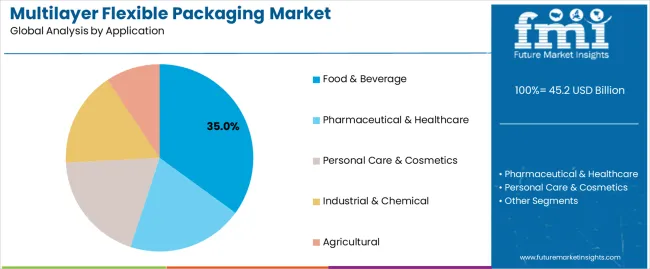
Market Context: Food & Beverage applications demonstrate the highest growth rate in the multilayer flexible packaging market with 5.4% CAGR due to widespread adoption of extended shelf-life packaging and increasing focus on food preservation optimization, consumer convenience, and supply chain efficiency applications that maximize product freshness while maintaining quality standards.
Appeal Factors: Food & Beverage manufacturers prioritize packaging versatility, preservation effectiveness, and integration with existing processing infrastructure that enables coordinated packaging operations across multiple product lines. The segment benefits from substantial consumer demand and food industry modernization programs that emphasize the acquisition of advanced packaging systems for preservation optimization and consumer experience applications.
Growth Drivers: Food industry expansion programs incorporate multilayer packaging as standard material for processing operations, while e-commerce growth increases demand for protective packaging capabilities that comply with shipping standards and minimize product damage during distribution.
Market Challenges: Varying preservation requirements and material compatibility may limit packaging standardization across different products or distribution scenarios.
Application dynamics include:
Pharmaceutical & Healthcare applications capture market share through specialized barrier requirements in drug packaging, medical device protection, and sterile packaging applications. These facilities demand high-performance barrier systems capable of maintaining product integrity while providing effective protection access and regulatory compliance capabilities.
Personal Care & Cosmetics applications account for market share, including premium product packaging, aesthetic enhancement, and brand differentiation requiring superior appearance capabilities for consumer appeal and product protection.
Market Position: Co-extrusion technology commands significant market position with 5.2% CAGR through optimal layer integration that meets performance and cost efficiency for diverse packaging applications.
Value Drivers: This technology provides the ideal combination of barrier properties and processing economics, meeting requirements for food packaging, pharmaceutical applications, and industrial uses without excessive complexity or manufacturing difficulties.
Growth Characteristics: The segment benefits from broad applicability across packaging sectors, established processing capabilities, and proven manufacturing programs that support widespread adoption and operational efficiency.
Market Context: Pouches dominate the market with 5.6% CAGR, reflecting the primary consumer preference for convenient packaging formats in food and consumer products.
Business Model Advantages: Pouches provide direct consumer appeal through convenience features, portion control benefits, and storage efficiency while maintaining barrier performance and product protection requirements.
Operational Benefits: Pouch applications include ready-to-eat foods, beverages, and consumer products that drive consistent demand for flexible packaging while providing access to latest convenience technologies.
| Category | Factor | Impact | Why It Matters |
|---|---|---|---|
| Driver | Consumer demand for convenience & portion control (on-the-go lifestyles, single-serve formats) | ★★★★★ | Drives innovation in packaging formats and sizes; creates premium pricing opportunities for convenience-focused solutions with enhanced consumer experience. |
| Driver | E-commerce growth & shipping protection requirements (product damage prevention, logistics optimization) | ★★★★★ | Transforms packaging from "product protection" to "shipping survival"; vendors that provide logistics-optimized solutions gain competitive advantage in distribution. |
| Driver | Food waste reduction & shelf-life extension demands (global food security, cost pressures) | ★★★★☆ | Extended shelf-life packaging becomes essential; demand for advanced barrier properties and preservation technologies expanding addressable market significantly. |
| Restraint | Raw material price volatility & supply chain disruptions (petroleum-based materials, transportation costs) | ★★★★☆ | Increases packaging costs and margin pressure; affects pricing strategies and forces efficiency improvements in material utilization and waste reduction. |
| Restraint | Complex recycling infrastructure & waste management challenges (mixed materials, collection systems) | ★★★☆☆ | Limits adoption of multilayer solutions in environmentally conscious markets; increases pressure for mono-material alternatives and circular economy compliance. |
| Trend | Smart packaging integration & digital connectivity (freshness sensors, QR codes, NFC technology) | ★★★★★ | Real-time product monitoring, consumer engagement, and supply chain transparency transform packaging; connectivity and digital integration become core value propositions. |
| Trend | Circular economy & material innovation (bio-based materials, chemical recycling, design for circularity) | ★★★★☆ | Environmental regulations drive material innovation; sustainable packaging solutions and end-of-life programs become competitive differentiators in premium markets. |
The multilayer flexible packaging market demonstrates varied regional dynamics with Growth Leaders including India (6.8% growth rate) and China (6.2% growth rate) driving expansion through food processing modernization and consumer goods development. Steady Performers encompass United States (4.7% growth rate), Germany (4.3% growth rate), and developed regions, benefiting from established food industries and advanced packaging technology adoption. Emerging Markets feature Brazil (5.9% growth rate) and developing regions, where urbanization and rising consumer spending support consistent growth patterns.
Regional synthesis reveals Asian markets leading adoption through food industry expansion and consumer lifestyle development, while North American countries maintain steady expansion supported by e-commerce growth and packaging innovation requirements. European markets show moderate growth driven by premium food applications and environmental compliance trends.
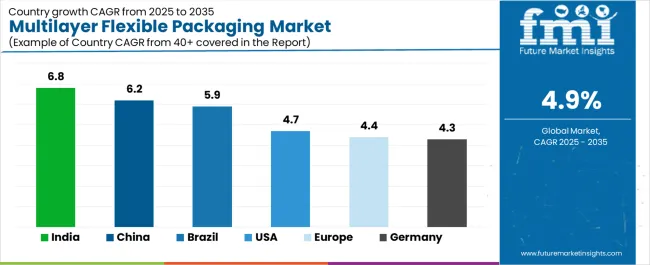
| Region/Country | 2025-2035 Growth | How to win | What to watch out |
|---|---|---|---|
| India | 6.8% | Focus on cost-effective barrier solutions | Infrastructure limitations; price sensitivity |
| China | 6.2% | Lead with high-speed production systems | Environmental regulations; local competition |
| United States | 4.7% | Provide premium convenience packaging | Recycling mandates; labor shortages |
| Germany | 4.3% | Offer precision engineered solutions | Over-specification; lengthy approval processes |
| Brazil | 5.9% | Value-oriented food packaging | Economic volatility; import dependencies |
| Europe | 4.4% | Push circular economy solutions | Complex regulations; fragmented markets |
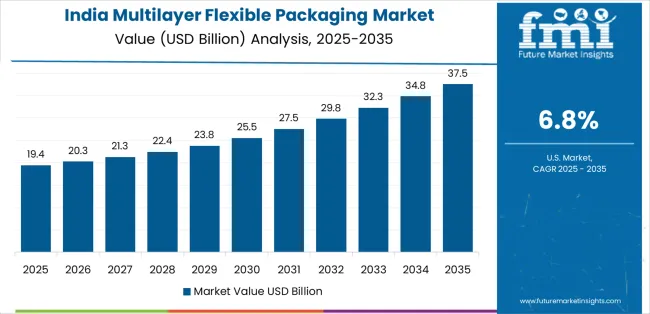
India establishes fastest market growth through aggressive food processing modernization programs and comprehensive consumer goods development, integrating advanced multilayer flexible packaging as standard components in processed food manufacturing and consumer product packaging installations. The country's 6.8% growth rate reflects government initiatives promoting food processing and domestic manufacturing capabilities that mandate the use of advanced packaging systems in food and consumer goods facilities. Growth concentrates in major industrial hubs, including Mumbai, Delhi, and Bangalore, where food processing technology development showcases integrated packaging systems that appeal to manufacturers seeking advanced preservation optimization capabilities and consumer convenience applications.
Indian manufacturers are developing cost-effective packaging solutions that combine domestic production advantages with advanced barrier features, including moisture control systems and enhanced preservation capabilities. Distribution channels through food processing equipment suppliers and packaging service distributors expand market access, while government support for food processing supports adoption across diverse food and consumer goods segments.
Strategic Market Indicators:
In Shanghai, Guangzhou, and Shenzhen, food processing facilities and consumer goods plants are implementing advanced multilayer flexible packaging as standard material for preservation optimization and consumer appeal applications, driven by increasing consumer spending and manufacturing modernization programs that emphasize the importance of product quality capabilities. The market holds a 6.2% growth rate, supported by urbanization trends and consumer lifestyle development programs that promote advanced packaging systems for food and consumer goods facilities. Chinese operators are adopting packaging systems that provide consistent preservation performance and consumer convenience features, particularly appealing in urban regions where product quality and convenience represent critical consumer requirements.
Market expansion benefits from growing consumer goods manufacturing capabilities and international technology partnerships that enable domestic production of advanced packaging systems for food and consumer applications. Technology adoption follows patterns established in consumer goods manufacturing, where quality and consumer appeal drive procurement decisions and operational deployment.
Market Intelligence Brief:
United States establishes market leadership through comprehensive food industry programs and advanced consumer goods infrastructure development, integrating multilayer flexible packaging across food processing and consumer product applications. The country's 4.7% growth rate reflects established food industry relationships and mature packaging technology adoption that supports widespread use of advanced packaging systems in food processing and consumer goods facilities. Growth concentrates in major food processing centers, including California, Illinois, and Texas, where packaging technology showcases mature system deployment that appeals to manufacturers seeking proven preservation capabilities and consumer convenience applications.
American packaging providers leverage established distribution networks and comprehensive service capabilities, including technical support programs and performance guarantees that create customer relationships and operational advantages. The market benefits from mature food safety standards and consumer requirements that mandate advanced packaging use while supporting technology advancement and operational optimization.
Market Intelligence Brief:
Germany's advanced packaging technology market demonstrates sophisticated multilayer flexible packaging deployment with documented operational effectiveness in food processing applications and consumer goods facilities through integration with existing quality systems and manufacturing infrastructure. The country leverages engineering expertise in packaging technology and quality systems integration to maintain a 4.3% growth rate. Industrial centers, including Baden-Württemberg, Bavaria, and North Rhine-Westphalia, showcase premium installations where packaging systems integrate with comprehensive manufacturing platforms and quality management systems to optimize production operations and consumer satisfaction effectiveness.
German manufacturers prioritize system precision and EU compliance in packaging material development, creating demand for premium systems with advanced features, including facility monitoring integration and automated quality systems. The market benefits from established packaging technology infrastructure and a willingness to invest in advanced manufacturing technologies that provide long-term operational benefits and compliance with international food safety standards.
Market Intelligence Brief:
Brazil's market expansion benefits from diverse food industry demand, including processing modernization in São Paulo and Rio de Janeiro, consumer goods facility upgrades, and government food programs that increasingly incorporate packaging solutions for product quality applications. The country maintains a 5.9% growth rate, driven by urbanization and increasing consumer spending recognition of packaging technology benefits, including product preservation and consumer convenience.
Market dynamics focus on cost-effective packaging solutions that balance advanced barrier performance with affordability considerations important to Brazilian food manufacturers. Growing consumer goods industrialization creates continued demand for modern packaging systems in new facility infrastructure and manufacturing modernization projects.
Strategic Market Considerations:
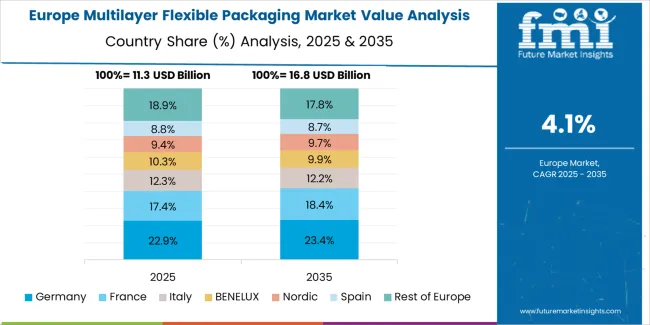
The European multilayer flexible packaging market is projected to grow from USD 12.8 billion in 2025 to USD 19.2 billion by 2035, registering a CAGR of 4.4% over the forecast period. Germany is expected to maintain its leadership position with a 31.2% market share in 2025, supported by its advanced packaging technology infrastructure and major food processing centers.
France follows with a 19.6% share in 2025, driven by comprehensive food industry programs and premium packaging technology development initiatives. United Kingdom holds a 16.8% share through specialized food applications and consumer goods requirements. Italy commands a 14.3% share, while Spain accounts for 12.4% in 2025. The rest of Europe region is anticipated to gain momentum, expanding its collective share from 5.7% to 6.3% by 2035, attributed to increasing packaging adoption in Nordic countries and emerging food facilities implementing processing modernization programs.
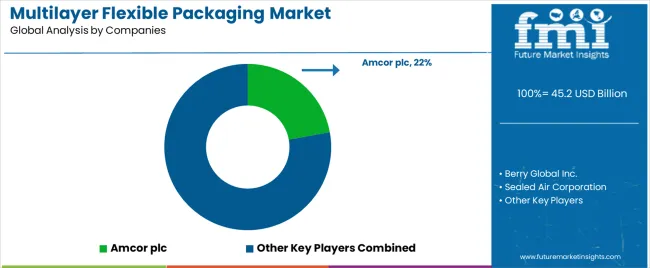
| Stakeholder | What they actually control | Typical strengths | Typical blind spots |
|---|---|---|---|
| Global platforms | Distribution reach, broad material portfolios, manufacturing scale | Global availability, proven reliability, multi-region support | Innovation speed; local customization complexity |
| Technology innovators | R&D capabilities; advanced barrier systems; smart packaging integration | Latest features first; attractive performance on specialized applications | Service density outside core regions; cost competitiveness |
| Regional specialists | Local compliance, fast delivery, nearby technical support | "Close to customer" service; pragmatic pricing; local regulations | Technology gaps; talent retention in technical roles |
| Material-focused ecosystems | Raw material access, processing expertise, supply chain control | Lowest material costs; comprehensive material solutions | Market diversification; customer concentration risk |
| Application specialists | Specialized segments, custom solutions, industry expertise | Win niche applications; flexible configurations | Scalability limitations; narrow market exposure |
| Item | Value |
|---|---|
| Quantitative Units | USD 45.2 billion |
| Material Type | Polyethylene-based Films, Polypropylene-based Films, Polyamide-based Films, Specialty Barrier Materials |
| Application | Food & Beverage, Pharmaceutical & Healthcare, Personal Care & Cosmetics, Industrial & Chemical, Agricultural |
| Technology | Co-extrusion, Lamination, Coating, Metallization |
| End Use Format | Pouches, Bags, Wraps, Lidding Films, Specialized Packaging |
| Regions Covered | North America, Latin America, Europe, Asia Pacific, Middle East & Africa |
| Countries Covered | United States, China, Germany, India, United Kingdom, Japan, Canada, Brazil, France, Australia, and 30+ additional countries |
| Key Companies Profiled | Amcor plc, Berry Global Inc., Sealed Air Corporation, Mondi Group, Constantia Flexibles, Huhtamaki Oyj, Sonoco Products Company, Winpak Ltd., Coveris Holdings S.A., Schott AG |
| Additional Attributes | Dollar sales by material type and application categories, regional adoption trends across Asia Pacific, North America, and Europe, competitive landscape with packaging technology manufacturers and material suppliers, food manufacturer preferences for barrier control and preservation effectiveness, integration with processing platforms and quality monitoring systems, innovations in packaging technology and barrier enhancement, and development of smart packaging solutions with enhanced performance and consumer convenience optimization capabilities. |
The global multilayer flexible packaging market is estimated to be valued at USD 45.2 billion in 2025.
The market size for the multilayer flexible packaging market is projected to reach USD 72.9 billion by 2035.
The multilayer flexible packaging market is expected to grow at a 4.9% CAGR between 2025 and 2035.
The key product types in multilayer flexible packaging market are polyethylene-based films, polypropylene-based films, polyamide-based films and specialty barrier materials.
In terms of application, food & beverage segment to command 35.0% share in the multilayer flexible packaging market in 2025.






Full Research Suite comprises of:
Market outlook & trends analysis
Interviews & case studies
Strategic recommendations
Vendor profiles & capabilities analysis
5-year forecasts
8 regions and 60+ country-level data splits
Market segment data splits
12 months of continuous data updates
DELIVERED AS:
PDF EXCEL ONLINE
Market Share Breakdown of Multilayer Flexible Packaging Manufacturers
Multilayer Transparent Conductors Market Size and Share Forecast Outlook 2025 to 2035
Flexible Rubber Sheets Market Size and Share Forecast Outlook 2025 to 2035
Flexible Printed Circuit Boards Market Size and Share Forecast Outlook 2025 to 2035
Flexible Electronic Market Size and Share Forecast Outlook 2025 to 2035
Flexible Foam Market Size and Share Forecast Outlook 2025 to 2035
Flexible AC Current Transmission System Market Size and Share Forecast Outlook 2025 to 2035
Flexible End-Load Cartoner Market Size and Share Forecast Outlook 2025 to 2035
Flexible Screens Market Size and Share Forecast Outlook 2025 to 2035
Flexible Metallic Conduit Market Size and Share Forecast Outlook 2025 to 2035
Flexible Electrical Conduit Market Size and Share Forecast Outlook 2025 to 2035
Flexible Display Market Size and Share Forecast Outlook 2025 to 2035
Flexible Substrate Market Size and Share Forecast Outlook 2025 to 2035
Flexible Paper Battery Market Size and Share Forecast Outlook 2025 to 2035
Flexible Metallic Tubing Market Size and Share Forecast Outlook 2025 to 2035
Flexible Barrier Films for Electronics Market Size and Share Forecast Outlook 2025 to 2035
Flexible Colored PU Foams Market Growth - Trends & Forecast 2025 to 2035
Flexible Endoscopes Market Growth - Trends & Forecast 2025 to 2035
Flexible Pipes Market Analysis by Application, Material, and Region: Forecast for 2025 to 2035
Flexible Thin Film Market Trends - Growth & Forecast 2025 to 2035

Thank you!
You will receive an email from our Business Development Manager. Please be sure to check your SPAM/JUNK folder too.
Chat With
MaRIA